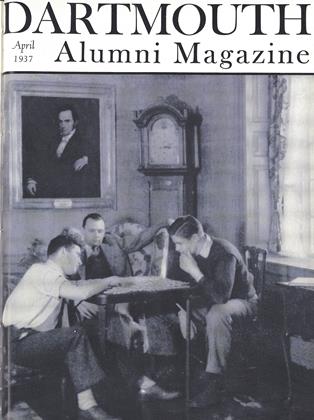By Eleanor von Erdberg. Edited by Bremer W. Pond '07, Harvard University Press, Cambridge, Massachusetts, 1936. p. 201. $5.00.
Among the numerous delights the parks and gardens of the late eighteenth century have to offer, its architectural chinoiseries are certainly the most delightful attractions. Such structures as pagodas, Chinese pavilions and bridges, are obligatory attributes of any park and garden of that period. The preference for buildings in the Chinese taste is another offspring of that love for the fanciful and bizarre which is characteristic of the Rococo period; and with its charm and lure of the rare and exotic the Chinese element was heartily welcomed in building up the ornamental stage-setting which was to form the background of a carefree society mainly devoted to play and display.
To the Chinese influence on European garden structures, Miss Eleanor von Erdberg has devoted an elaborate and illuminating study, published by the Harvard University Press. The author shows the various sources from which Europe drew her knowledge of Chinese architecture. The most important of these sources were the drawings and water-colors furnished by the French jesuits in Peking and numerous travel books published since the middle of the eighteenth century. Among these books the works of the English architect William Chambers on Chinese Buildings and Oriental gardening gained tremendous influence spreading the new fashion all over Europe.
This knowledge of Chinese gardening came to Europe just at the time when she was getting tired of the French formal garden which subdued even nature to the rigid laws of Geometry. It was, as the author shows, the example of the Chinese garden with its different miniature landscapes of varying moods, with its winding paths and meandering waterplanes, which was now used as an effective weapon in the fight against the formal style introduced by Le Notre. There was, and still is, much controversy about the invention of the landscape garden. We are assured by the author that it was the English who introduced to Europe the knowledge of Chinese garden architecture; and they first developed the landscape park following in its design the Chinese pattern of assymmetry and imitation of nature as opposed to the formal style.
From that time, every garden owner was ambitious to have on his place, be it even so small, a Chinese garden with its exotic plants and strange architectural appurtenances. The author gives an almost complete list and full description of those new developments and structures, reaching from the first example, the Trianon de Porcelain in the Park of Versailles (1670) over the Great Pagoda in Kew Garden, designed by Chambers in 1761, to the Chinese Bridge in St. James Park in London, built by John Nash in 1815, at a time when the Greek Revival put an end to the Chinese fashion.
With her scholarly study, accompanied by a great number of illustrations, the author succeeded in writing a readable and entertaining book, illuminating a period which is still close to the heart of every garden lover. Professor Pond of the Harvard School of Landscape is the translator of this volume from the German. He did not attempt a literal translation of the text but made a number of changes to adapt it to English and to make it of more interest to American readers. Those not reading German easily will be grateful to Professor Pond for his efforts in making this book available in an English translation.
 View Full Issue
View Full Issue
More From This Issue
-
 Sports
SportsDeaths
April 1937 -
 Article
ArticleFootball From the Inside Out
April 1937 By DAVID M. CAMERER '37 -
 Sports
SportsFollowing the Big Green Teams
April 1937 By ROBERT P. FULLER '37 -
 Class Notes
Class NotesClass of 1902
April 1937 By Hermon W. Farwell -
 Class Notes
Class NotesClass of 1927
April 1937 By Doane Arnold -
 Article
ArticleGradus Ad Parnassum
April 1937
Books
-
 Books
BooksFACULTY PUBLICATIONS
October 1942 -
 Books
BooksPROBLEMS IN INCOME TAX FUNDAMENTALS.
October 1937 By C. W. Sargent '15 -
 Books
BooksTHE WATERVILLE VALLEY, A STORY OF A RESORT IN THE NEW HAMPSHIRE MOUNTAINS
November 1952 By Francis L. Childs '06 -
 Books
BooksSTRUCTURAL MODELS:
JANUARY 1966 By JACK E. GRAVER -
 Books
BooksTHE GREAT TECHNOLOGY
October 1933 By McQuilkin DE Grange -
 Books
BooksSAINTS ON MAIN STREET.
March 1960 By THOMAS S.K. SCOTT-CRAIG

